MILFORD SOUND: OUR COMPLETE GUIDE
This post is all about the most popular attraction in not only New Zealand, but in all of Oceania: Milford Sound. It is deserving of all the praise it attracts, but a bit of planning can make your visit even more enjoyable. What month is best? What time of the day? How to get there? What’s along the way? How do I need to prepare? We will tell you how we did it and offer information to let you decide how best to visit for yourself.
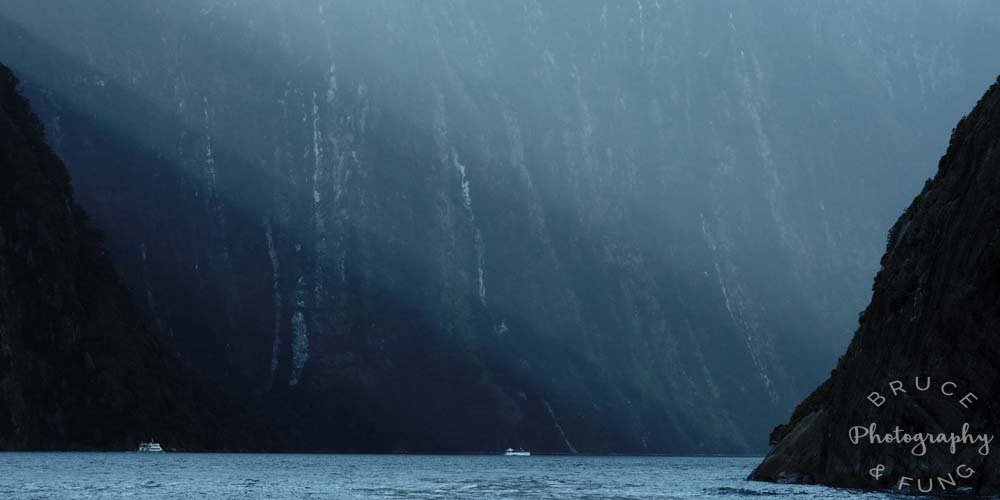
Above: Cruise boats touring the fiord. Further above: The iconic site that greets you as you arrive – Mitre Peak.
MILFORD SOUND IS AMAZING, BUT IT CAN BE VERY BUSY
New Zealand is one of the most awe-inspiring countries on this planet. It is difficult to find a boring drive while touring around either the North Island or the South Island. That said, the South Island does offer something that the North Island lacks: the dramatic mountain scenery of the Southern Alps, which extend down most of the western side of the island.
If we had to declare which part of this achingly picturesque country is the most breathtaking, it must be the Fiordland National Park, over 1.2 million hectares in size, nestled into the southwest corner of the South Island. The vistas on offer in this area are truly spectacular. Fiordland National Park, along with Mt Aspiring National Park, Aoraki / Mt Cook National Park and Westland National Park, makes up Te Wahipounamu (Māori for “the place of greenstone”), recognized by UNESCO as a World Heritage Site in 1990. It is a unique and special area; one which most of the visitors to New Zealand have on their wish list.
But access is very limited, so the great majority of all the tourists who come to this region are funnelled to Milford Sound on a day trip. That’s over half of a million visitors per year.
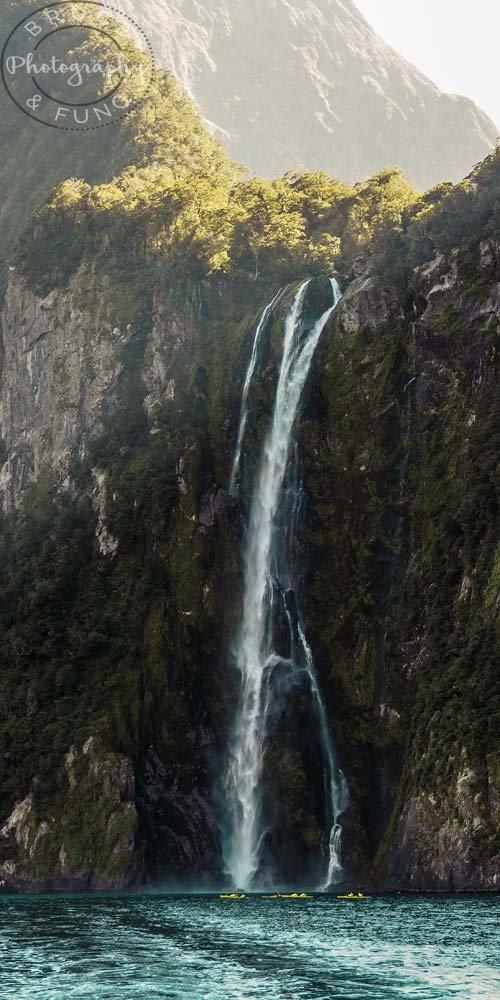
A group of kayakers approaching Stirling Falls, which is a lofty 155 meters in height.
HOW TO GET THERE
There are numerous options for how to “do” Milford Sound. One can do overnight boat trips in Fiordland, centred on Milford Sound or nearby Doubtful Sound. There are scenic flights in both light plane and helicopter over the region, which though expensive, are very popular. Some tours to Milford offer flying in or flying out combined with a one-way bus transfer, or simply flying both ways. Hiking (known as “Tramping” in the local lingo) is a big drawing card and very well-run, with some of the most world-renowned tracks located in the area, with the Milford Track being the most popular track in New Zealand and often called the “world’s finest walk”. Kayaking is another way to see the fiord.
But most folks visit Milford by either going along on a bus tour or by self-drive and then take a cruise on the 15 km-long (just over 9 miles) sound, from the head of the fiord to the open Tasman Sea and back in a comfortable two hours or so.
Most of the tourists come all the way from Queenstown, which is a 4-hour dive (5 hours in winter) each way. Adding the cruise and a few picture stops makes it a 12-hour trip, which is a long, if rewarding, day. If one could drive “as the crow flies”, the journey would only be half an hour or so, but the existing road goes south from Queenstown, following the scenic (of course) shoreline of Lake Wakatipu before turning west and continuing through Southland pastures until the lakeside town of Te Anau, which takes just over two hours without stopping. Then the road swings north, enters the park and you are subject to the relentless urge to repeatedly stop for photos along the way until you reach Milford Sound around two hours later (if you don’t stop, which is virtually impossible).
Staying in Te Anau (or nearby Manapouri, as we did) cuts the drive time in half and allows you to avoid the masses. We highly recommend doing this. There are numerous accommodation options in both places. We loved our well-appointed self-contained unit at Acheron Cottages.

The road from Queenstown, hugging the shore of Lake Wakatipu along the section known as The Devil’s Staircase.
OUR EXPERIENCE IN MILFORD SOUND
Our plan was to rise early and aim to arrive for a mid-morning cruise on the fiord (it’s actually not a sound, but the misnomer stuck) before the midday bus invasion from Queenstown. We read many recommendations to book on a 10 am cruise rather than the first one in the morning, since by then the sun would be high enough to properly light the fiord. With a sunrise around 7:30 late in April, that timing worked well for us. Even then, we didn’t actually see the sun above the high walls looming over the inlet until later into the cruise.
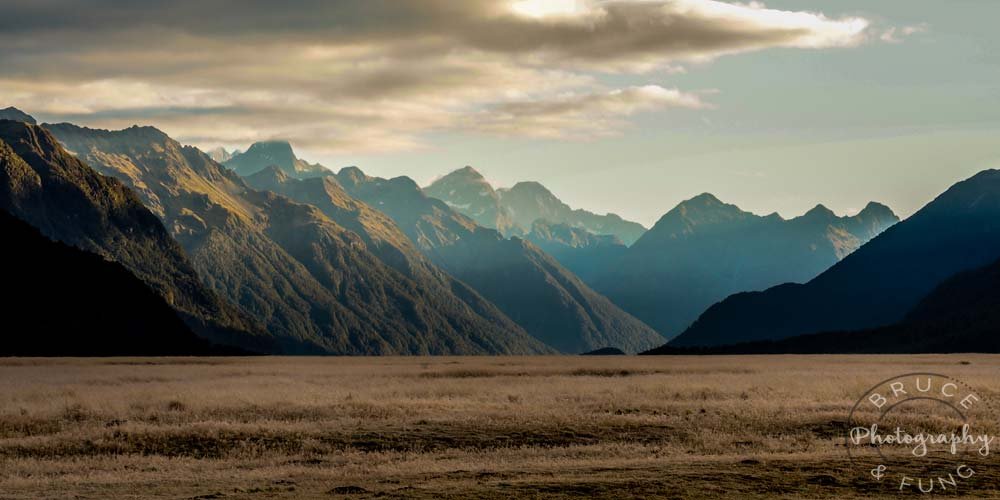
Frost-covered grasslands at dawn in the Eglinton Valley.
On rising before the sun at our little house in a field outside Manapouri, we were greeted by a special sight Everything, including our car, was covered in heavy frost. It was cooooold! Not only crisp, but clear! Lucky us! We bundled up and set off, seeing the same three or four cars as we passed each other on photo stops during the journey to Milford. There is only one route to the sound: State Highway 94, which is easily one of the most awe-inspiring roads in a country full of breathtaking drives.
We passed through forests, over rushing streams and crossed open grasslands. As we got closer to Milford, our valley abruptly ended. The route then plunged though the sloping, single lane 1.2 km Homer Tunnel. After the tunnel, the road windins down to the boat dock for Milford Sound. Being early in the day, we found the large parking lot almost empty.

Another frosty early morning scene along Highway 94, this time in the Hollyford Valley near Monkey Creek.
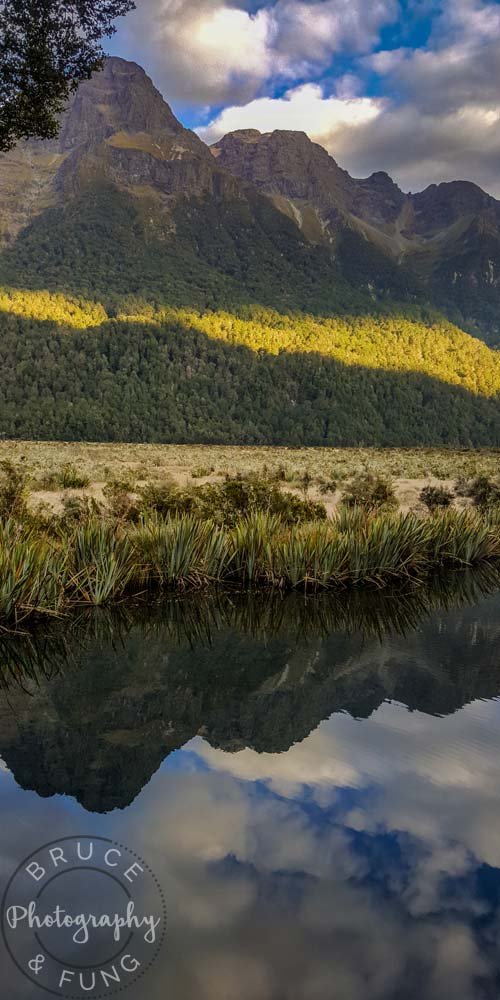

Left: the must-see early morning stop – Mirror Lakes. Right: Our boat for the morning – Mitre Peak Cruises.
There are a number of companies offering cruises on the sound (90 min, 2 hrs, or even 2.5 hrs) along with transportation options (if needed) and we were very happy with our pick: Mitre Peak Cruises, who go further than the other boats and their comfortable boat may actually be the smallest in the fleet.
Most Milford Sound cruise boats have both indoor and outdoor seating. If you’d prefer to stay inside and keep warm, you’ll still be able to enjoy the amazing views out the window. As it was cold, we preferred to start off our cruise comfortably indoors, warming up with their free hot drinks. We didn’t stay inside for long though, as only minutes out from the dock we were drawn out to the deck to enjoy the attention of a pod of Bottlenose Dolphins. They stayed with us for around fifteen minutes and we were accompanied once more by them on our return, near the end of the trip as a final bonus.
This was Bruce’s second trip to Milford. On his first visit, years earlier in the month of October, during the opposite shoulder season, he experienced the opposite weather: pouring rain. This is quite normal for the area, since it rains two out of every three days on average. But on the plus side, the precipitation causes countless waterfalls to form along the vertiginous sides of the fiord, which is a glorious spectacle.
On this clear day we kept dry (if a bit cold) and had the established waterfalls to marvel at. We also actually left the fiord, getting a taste of the open ocean swell and taking note of how easily the entrance could be missed by passing ships as it disappears once you leave the relatively narrow crooked inlet. On our return we paused by rocks which had New Zealand fur seals sunbathing and the Captain nosed the bow of the boat underneath the tall Stirling Falls (pictured with kayaks), though only one passenger was brave (and nuts) enough to accept the frigid soaking on offer.
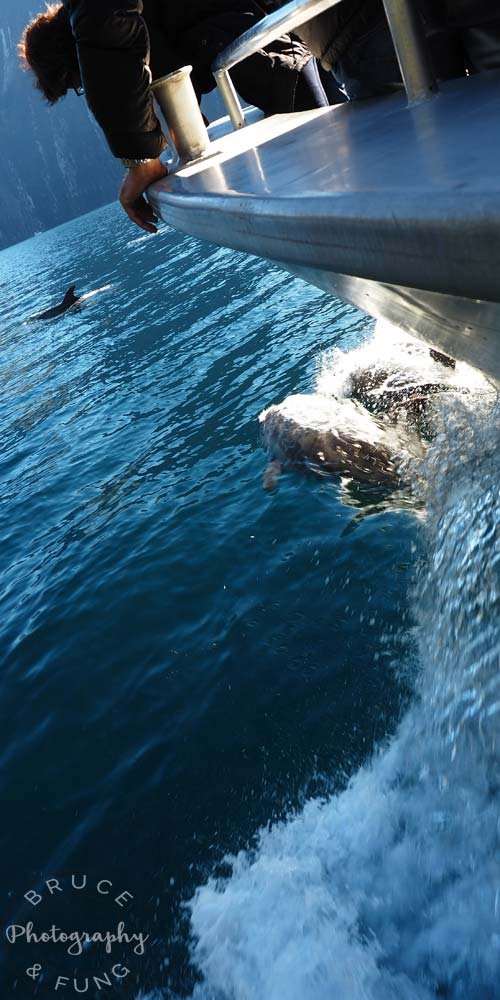

The resident pod of bottlenose dolphins surfing on our bow waves.
Our timing was perfect, because when we disembarked, crowds awaited and the parking lot was filling up. As for the ever-changing New Zealand weather, it was a different situation as well. En route back to Manapouri, passing many buses heading the opposite direction, the skies had clouded over and the wind had picked up, nullifying the reflection at the aptly-named Mirror Lakes that we had appreciated earlier that morning. There are some short walking trails along the route and we recommend trying any of these on your way out after your boat trip, since you have all afternoon if you went on a morning cruise.


Forest views heading to Milford, after the Homer Tunnel.
IT’S NOT A SOUND, BUT A FIORD
As mentioned earlier, yes, it is a fiord (Folks in Scandinavia would spell it “fjord” but the Kiwis have their own spelling), not a sound. The early European settlers named this place Milford Sound – but they were incorrect. Sounds are formed when a river valley is flooded by the sea, whereas Milford Sound was formed by the grinding erosion of ancient glaciers: During the ice age both the ice and the rivers carved deep valleys in the mountains. As the climate changed, most of the ice melted, and the valleys were gradually filled with salt water from the coast, thus creating the fiords. In the case of Milford Sound the water is up to 400 meters (1,312 feet) deep, though that is not nearly as deep as some fiords elsewhere. There is such a high volume of rain and runoff into the fiord that a layer of tannin-rich fresh water sits atop the salt water that is 2-6 meters deep and blocks so much light that the water can appear black.
PREPARE FOR RAIN
If going to Milford Sound, expect rain. Milford Sound is the wettest inhabited place in New Zealand, and one of the wettest places in the world! The average annual rainfall is 7 meters! They have even measured 9 meters in a year, which is amazing! On rainy days, countless waterfalls are created, both along the drive to Milford as well as cascading down the cliff faces of the fiord, some reaching a thousand metres in height. Some smaller falls start from such a great height that they turn into mist which is blown away before even reaching the ocean. So, rain or shine, it will be spectacular.
If you have the time to spend a few days in the area, you can monitor the weather reports and book last-minute to try to hit a clear day if you really wish to avoid rain. Don’t expect to find last-minute vacancies on mid-day cruises along with most cruises during the high season (December-March). But you can try. And still bring a jacket for the rain and cold because no matter the forecast, you may still experience the proverbial four seasons in one day that New Zealand is rightly famous for.
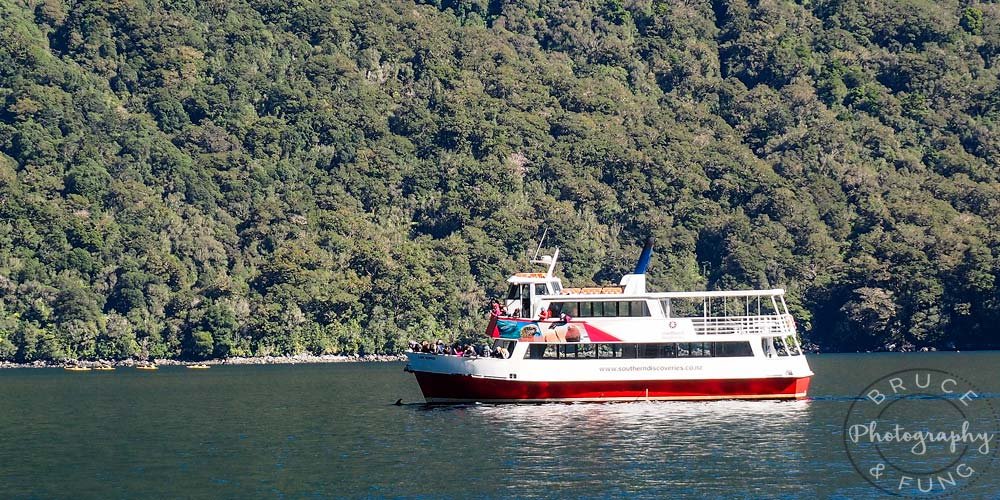
One of the boats with an attending bottlenose dolphin, along with some kayakers are over by the shore.
WHAT TO EXPECT
Summer (December – February): This is the pinnacle of the peak season, when up to 2,000 visitors/day are expected and advance bookings are necessary. A shuttle service from the overflow parking lot is offered from December-March. You should add half an hour to your inbound trip plan if you think you may need it since the available parking fills up fast in the high season. It is also not only the warmest time of the year, with an average temperature of 20˚C (but it can get up to 29˚C), but December and January are the rainiest months of the year in Milford.
Spring (March – May): March is still part of the peak season, but April and May are considered the shoulder season, which has less crowds and a much higher chance of enjoying clear weather. In May the winter conditions begin with the arrival of snow. Road closures may be a factor and if self-driving, you will be required to carry snow chains.
Winter (June – August): This is the low season. The average daily temperature is around 4˚C, making it bitingly cold out on deck during the cruise. As stated above, snow chains are required and you’ll need to know how to put them on if you are driving yourself to Milford. Snow chains can be rented in Te Anau if your rental car doesn’t have any included. The beautiful white peaks of the Southern Alps contrasting with the lush greens of the forests below are very photogenic at this time of year, but avalanche warnings can cause the Milford Road to close on some occasions. In order to avoid disappointment, it’s important to check the Milford Sound weather forecast and road information before you travel. A good source of information is the NZTA road status page. Along the route there are also roadside information signs at Te Anau, Knobs Flat and Milford to advise on current road conditions.
Spring (September – November): In September still expect winter conditions, so follow the advisories above. September and October are shoulder season, so expect less crowds and a better chance for sunny days. The mountains are still capped with snow, but snowmelt and spring rains bring the waterfalls to life and the wildflowers into bloom. Once into November, you are back into the high season, with more bodies in play.
WILDLIFE IN THE FIORD
The wildlife in the area is more active in the colder months, especially the penguins. We didn’t see any on our trips to Milford, but the little blue penguin is a resident species, while the fiordland crested penguin is seen commonly from July-November. New Zealand fur seals are a fixture of the cruise itinerary, while bottlenose dolphins are regularly encountered, reaching a larger size in the region compared to their tropical counterparts. Dusky dolphins are irregular visitors to the inlet, while southern right whales are seen, but rarely.

Basking New Zealand fur seals at the aptly-named Seal Rock.
TAKE NOTE
- There is no cellphone coverage along the Milford Highway.
- Fill up your vehicle with fuel before leaving Te Anau as there is a very limited supply of fuel at Milford. There are no shops or petrol stations between Te Anau and Milford Sound, so make sure that you have ample food and drinks for your journey.
- Using the public restrooms in Te Anau before embarking on the long drive to Milford Sound is a good idea. After Te Anau, there are public toilets on the Milford Road only at Knobs Flat and The Divide.
- Be aware that delays can occur at the Homer Tunnel as well as elsewhere along the route. Passing can be difficult along some of the road owing to traffic during peak times.
Both ends of the 1.2 km-long Homer Tunnel, gateway to Milford.
YOUR VISIT TO MILFORD SOUND
No matter when you visit, Milford Sound will be spectacular, no matter the weather. Bring suitable clothing for both rain or shine. We recommend that you try to avoid the high season, which applies to most popular tourist destinations. Try to book a morning cruise, thus beating the rush. In order to make that morning cruise feasible, stay closer than Queenstown, preferably in Te Anau or Manapouri. That’s our advice. Now go and enjoy what Rudyard Kipling called “The Eighth Wonder of the World” and New Zealand’s most famous tourist destination: the fiord they call Milford Sound.




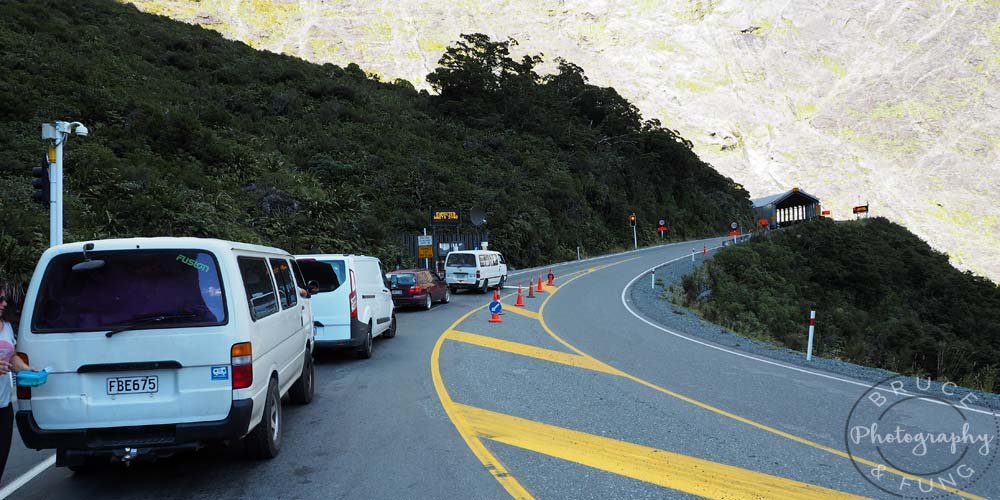













 Visit Today : 9
Visit Today : 9 This Month : 1186
This Month : 1186 This Year : 7608
This Year : 7608 Total Visit :
Total Visit :